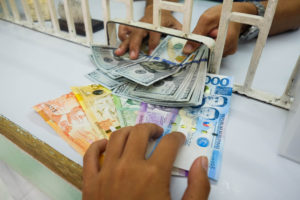
There are winners and losers when the peso is weak.
Final Thursday, the native foreign money revisited the record-low 59:$1 it final touched on Oct. 17, 2022—again when an additional hawkish US Federal Reserve propped up the greenback and set off a rampage throughout different currencies.
However this time, the peso hunch is being fueled by world uncertainties following Donald Trump’s gorgeous election victory, which stoked fears of a worldwide commerce struggle because the president-elect had warned of common tariffs on all imported items in america.
READ: Peso hits record-low 59 as Trump 2.0 boosts greenback
That very same unease can also be tempering expectations of larger fee cuts by the Fed, including energy to the resurgent greenback.
The Bangko Sentral ng Pilipinas (BSP), for its half, blamed the peso’s fall on geopolitical tensions amid the escalating Russia-Ukraine struggle, which is driving “protected haven” demand for the buck.
Article continues after this commercial
“The peso traded consistent with the regional currencies we benchmark towards,” the BSP mentioned on Friday.
Article continues after this commercial
As it’s, the present weak point of the peso has stoked each worries and cheers at house, relying on who’s saying it.
Influence
A cratering peso is alleged to profit Filipino migrant staff as a result of the peso worth of their remittances rises when the native foreign money depreciates. This, in flip, can increase the spending energy of the households again house, which may add assist to family expenditures within the consumption-reliant Philippine financial system.
On the similar time, Filipino exporters can see positive factors when the peso dips because it makes their merchandise extra aggressive in worldwide markets.
However this example can create issues for the federal government and companies with massive exterior borrowings, which can see the peso worth of their foreign-currency denominated money owed rise when the native unit is weak.
Because of this fiscal planners are minimizing the state’s publicity to overseas money owed—presently accounting for 31.19 p.c of the P15.89-trillion debt pile of the federal government as of September—to keep away from too many overseas trade dangers.
Zooming out, a weakening peso would push up import prices for the Philippines, one thing that would fan inflation. Newest estimates from the BSP present the pass-through impact of the peso’s slide on inflation is at 0.036 share level per 1 p.c depreciation of the native foreign money.
BSP protection
Some analysts had flagged the dangers of a fee slicing pause by the BSP ought to the peso stay below stress.
BSP Governor Eli Remolona Jr. had floated the potential of an easing delay on the Dec. 19 assembly of the Financial Board, citing persistent value pressures.
To forestall the peso from weakening an excessive amount of and fanning inflation, the BSP chief mentioned the central financial institution had been intervening within the overseas trade market lately, albeit in “small quantities.”
On Friday, the peso appreciated by 13 centavos to shut at 58.87 versus the greenback, which a dealer attributed to “profit-taking forward of the weekend.”

